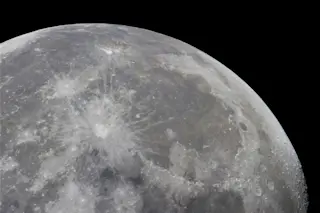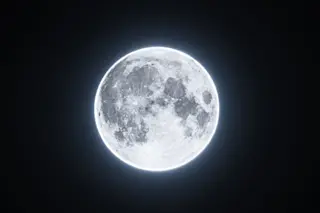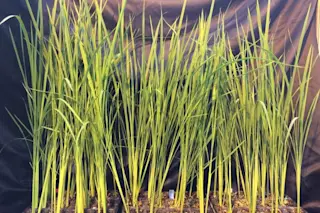Geoscientists have a good idea of how earthquakes happen. The Earth’s crust — which is on average 22 miles deep — is broken into continental and oceanic plates that rub against one another other due to the movement of molten rock in the Earth’s mantle. Over the decades and centuries, pressure builds at the points where the tectonic plates converge, until the plates crack and the pressure is released, sending shockwaves in all directions.
On the moon, however, things aren't quite the same. Though the lunar surface is also subject to tremors, scientists believe that their mechanisms are altogether quite different from those behind earthquakes on Earth. So, what, specifically, are moonquakes, and what causes them to occur?
What Are Moonquakes?
A moonquake is any sort of seismic tremor that occurs on the moon, shaking the surface of our only natural satellite, typically as a result of a sudden release of seismic waves.
These tremors are typically weaker than the tremors that occur on the Earth, though they do tend to last longer.
What Causes Moonquakes?
Moonquakes are caused by impacts from meteoroids striking the moon's surface. They’re also triggered by the structure and temperature of the moon, as well as the gravitational pull of the Earth.
“There are no active plate tectonics on the moon, so moonquakes occur as a result of different processes,” says Francesco Civilini, a planetary scientist at NASA’s Goddard Space Flight Center.
Read More: That Time Apollo Astronauts Detonated Explosives on the Moon
What Are the Different Types of Moonquakes?
For the most part, moonquakes fall into one of four separate categories, says Civilini.
Shallow Moonquakes
"Shallow moonquakes" are caused by structural weaknesses in the interior of the moon, which is shrinking slowly over time thanks to the cooling of its central core. These moonquakes are closest in character to earthquakes, and occur at depths of up to 125 miles.
Deep Moonquakes
"Deep moonquakes" are caused by tidal stressors from the Earth and tend to originate between 500 miles and 750 miles below the lunar surface.
Because the moon orbits the Earth in an elliptical orbit, it's closer to the Earth at certain points in its orbit and farther from the Earth at others. This causes a gravitationally induced compression and expansion of the body of the moon, similar to the compression and expansion of the Jovian moons Europa, Ganymede, and Callisto, contributing to the occurrence of moonquakes.
Meteoritic Moonquakes
Beyond shallow and deep tectonic events, there are also meteoritic moonquakes caused by the collision of meteorites and other objects from space.
Thermal Moonquakes
And lastly, there are "thermal moonquakes," which correlate to the moon's 30-day cycles of day and night and reflect the fluctuation of temperature and rhythm of thawing and freezing on the lunar surface. There, temperatures often fall from 130 degrees Celsius during the day to -173 degrees Celsius during the night.
Read More: Scientists Grow First Plants in Lunar Soil
The Conditions of Moonquakes
Recently, Civilini and two other researchers analyzed seismic data collected from the surface of the moon, in an attempt to characterize and determine the nature of seismic activity happening there. Their results appeared in the Journal of Geophysical Research: Planets in September 2023.
Specifically, the team turned to seismic data from an array of four geophone instruments deployed on the moon during Apollo 17 as a part of NASA's Lunar Seismic Profiling Experiment. The instruments were positioned in a square-shaped pattern to detect seismically generated ground vibrations, and they collected their data during a continuous 8-month period between August 1976 and April 1977.
Read More: The Moon Still Isn't the Cause of Big Earthquakes
Predicting Moonquakes
Throughout the course of their study, Civilini and colleagues developed algorithms to accurately determine the arrival timing of the seismic waves, to measure their strength, and to identify the direction of their source. They found two main sources of shaking: the vibrations of the lunar module, which was left on and behind by Apollo 17 astronauts while seismic recordings were being taken, and thermal moonquakes.
The researchers also noticed from their data that warmer temperatures were associated with longer readings on the seismogram records, meaning longer shakes during the duration of the moonquakes. Civilini and his team think this may be because the temperatures affected the properties of the rocks and materials on the moon’s surface.
Read More: The Search for Ice Deposits in Moon Craters
The Future of Moonquakes
With NASA’s upcoming plan to establish a long-term presence on the moon through the Artemis mission, a good question is whether future structures on the moon should be built with the potential hazards moonquakes might bring.
Here on Earth, earthquakes can pose serious problems. The sudden shaking of the ground can cause buildings, bridges, and other structures to crumble and collapse. It can also trigger other catastrophes, including tsunamis, which occur when debris is shifted on the seafloor. To avoid their devastation, we build cities to withstand the tremors and the natural disasters that accompany them. But would we do the same for settlements on the moon?
“Thermal moonquakes are very tiny, so they likely wouldn’t be hazardous to structures, but they give us insight into the thermal contraction and expansion that future equipment should be able to withstand. Shallow moonquakes, however, are strong enough that they could be of concern to a future base,” says Civilini.
NASA will have to keep them in mind then, especially if other moon-based observatories and scientific projects are to go ahead. And, of course, with a growing scientific presence being planned for the moon in the future, it's likely geologists and planetary scientists will be able to gather even more data on moonquakes and the internal structure and composition of the moon itself.
Read More: Reconsidering the Origins of Water Found on the Moon















